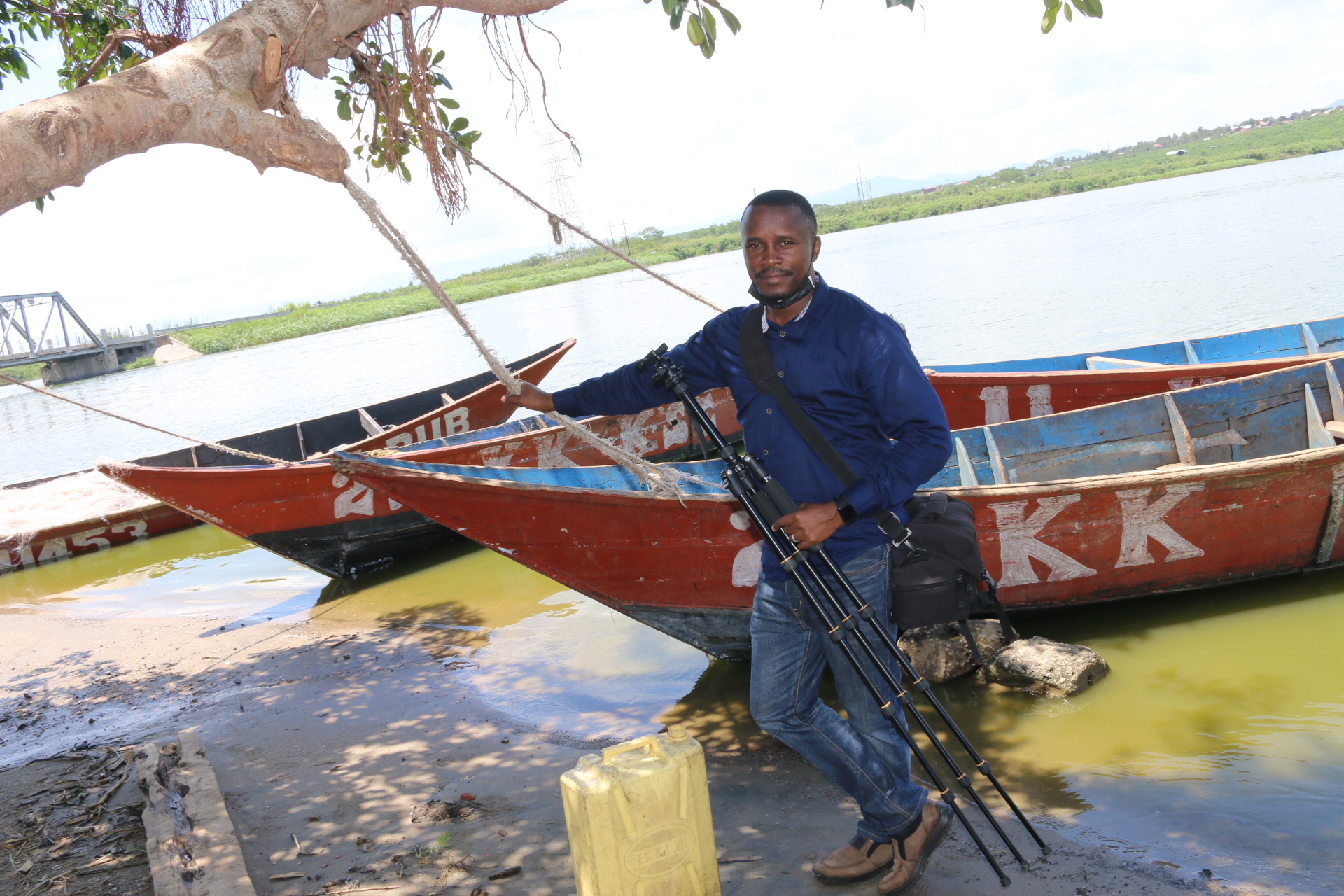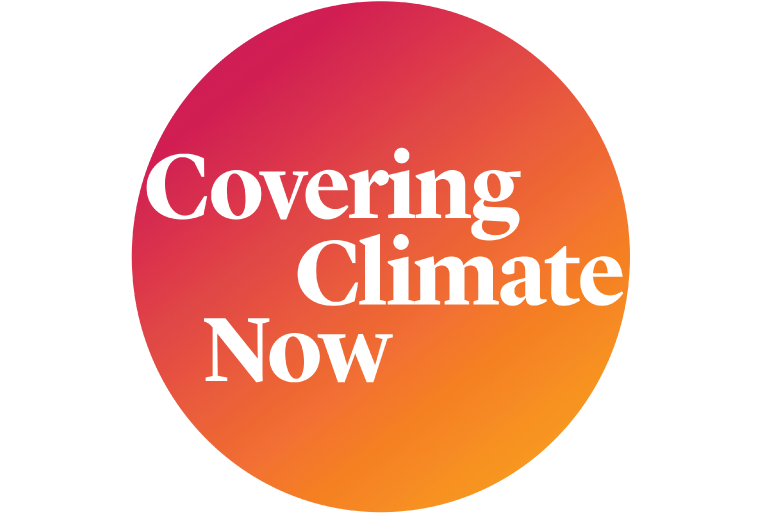Together, a thousand journalists can accomplish a lot. Ugandan journalist Fredrick Mugira is the founder of Water Journalists Africa, an extensive journalism collaboration with members in fifty African countries. Mugira and his Water Journalists Africa colleagues survey members regularly on emerging stories in their region. In 2020, they noticed an alarming trend: from East Africa, journalists were sharing that large and important lakes were shrinking and unable to sustain the livelihoods and prosperity that they once had. InfoNile, a subproject of Water Journalists Africa dedicated to environmental crises in the eleven countries comprised in the Nile Basin, set out to investigate. Two years later, InfoNile published its journalists’ findings in a sprawling report titled “Shrinking Lakes: Can East Africa Avoid Water Resources Apocalypse?”
Mugira and seventeen of his InfoNile colleagues are among this year’s finalists for the Covering Climate Now Journalism Awards. CCNow spoke recently with Mugira about his organizations’ collaborative approach to environment and climate stories, the need for climate journalists to reach new audiences, and urgent water stories that demand coverage on the African continent. The conversation, with CCNow deputy director Andrew McCormick, has been edited for length and clarity. Follow Mugira on social media.
What led you to focus on environmental and climate reporting?
At university, I studied journalism and mass communication, with a special focus on the environment. This was in 2005, when the story of climate change was just beginning to catch on, and, in fact, it was reporting on climate change that made me love being an environmental reporter.
In Uganda, particularly where I’m from in western Uganda, farmers were starting to question why they were suddenly unable to plant maize and millet at the time of year they normally had. I wanted to find the answer. I felt that, as a journalist, I had a duty to inform my community about what was happening.
Did you find there was an audience for climate stories?
I did. There was a clear audience, and as media houses started publishing more climate stories, I think many people did begin to understand. Those farmers might not have been able to explain climate change in detail, but they came to know that their planting seasons were shifting—that hotter weather than normal might burn their crops, or that heavy rains could come at unexpected times and destroy them. We have told many stories tying local disasters, like frequent flooding in Uganda’s capital, Kampala, to climate change, and this has helped people learn how climate change will affect their lives—and because of that, I believe, many people have begun trying to find solutions to the climate problems we face.
Now the challenge for journalists is that we’ve been telling climate stories for about two decades, and communities around East Africa might think they already know everything about climate change. I worry that the story we’ve been telling is getting old, and people will stop paying attention, even as the impacts of climate change are getting worse.
So I believe we need to resurrect the climate story—we need to find new storytelling forms that will help us attract new audiences. Our work needs urgency and enthusiasm.
You describe your organizations’ work as “geojournalism.” Is that partly your answer to this need for, as you say, new storytelling forms?
Geojournalism to us means that we use many tools to bring our stories to life—maps, drone imagery, data, and more, all layered on top of reporting and human stories. This mix of media helps us to attract a wider variety of readers: Young people enjoy our stories because they are interactive and have nice visuals; scientists like them because they present data in a new way; and community leaders like them because we present a lot of evidence that might help them make scientifically informed decisions about their changing environment. More readers mean a bigger impact on the ground—and we do find there is a lot of engagement around our stories.
Six months after a story publishes, we survey journalists involved—many of our stories at Water Journalists Africa are collaborations between journalists in different countries—to measure the story’s impact. What we hear from journalists in our network is that the multimedia and interactive elements of our work really help the stories sink down to the community level. They get people interested, and, in fact, we find that local media houses have taken inspiration from our stories and have pursued additional stories about the same issues. We like this, because we are a network of journalists; competition is not part of our mission.
Could you briefly describe the missions of Water Journalists Africa and InfoNile? How are the organizations related?
Water Journalists Africa is a network of journalists in fifty African countries reporting on the continent’s water resources. In addition to our collaborative reporting efforts, we conduct training, connect journalists with scientists and other experts, and, when we’re able, provide reporting grants to journalists to follow various water-related stories.
Water Journalists Africa has two major projects. InfoNile is the flagship, which I cofounded in 2016 with an American journalist named Annika McGinnis, and it focuses on environmental crises in the Nile River Basin, including climate change. And we have the Big Gorilla Story, which covers efforts to conserve the rainforest habitat of the endangered mountain gorillas in Uganda, Rwanda, and the Democratic Republic of the Congo.
When I started Water Journalists Africa in 2011, I would say that not many journalists were writing about water. We began with ten journalists who I recruited. Today, over twelve hundred journalists are registered members of our network, and at InfoNile, specifically, we work with nearly eight hundred journalists in eleven countries.
What are some of the key climate-change-related water stories that you’re following?
In my community in western Uganda, over the last seven years, about 60 percent of water wells have dried up, according to data from Uganda’s National Environment Management Authority. This is not unique; in many regions across Africa, wells and other water resources are drying up. So what do people have to do? They must walk longer and longer distances to fetch water, including to rivers and lakes, which are also at risk due to climate change—and then this encroachment separately contributes to the rivers and lakes drying up. This has many effects that link together.
One of the most important, for example, is conflict. You see entire communities migrating in search of water, and in the process, they are coming into conflict with other communities, who want to prevent people from accessing their water sources, because they fear it will result in those drying up. This has already sparked some violence, and I think we are bound to see more of this.
Heavy rains and floods are also resulting in more migration. People are fleeing parts of Uganda, Congo, Ethiopia, and Sudan, and sometimes governments cannot provide for them, so we find more people living in displacement camps. And this relates to poverty. If someone is living in a displacement camp, does he have the time to go back and grow crops where he came from? No.
One emerging story that I’m looking into is the impact of climate change on mental health. This is not talked about much, I feel, but if we connect the dots, we will realize it’s a big issue. I have read, for example, about farmers committing suicide because they were not able to harvest enough to pay off loans or feed their families; in the case of those farmers who noticed their planting seasons were shifting, we saw that because harvests were delayed by several months the farmers did not have money to pay for their children’s school fees on time. Things like this are breaking up families. At first, people may not attach such tragedies to mental health, but when you look closer, it’s a clear factor, and underlying that is climate change.
Tell us a bit more about the project “Shrinking Lakes: Can East Africa Avoid Water Resources Apocalypse?” How did that come together, and what sort of feedback have you gotten?
Once we had decided to follow the lakes story and secured funding—from a US-based grantmaking organization focused on biodiversity—we sent out a call for pitches and selected ten reporters in Kenya, Rwanda, Tanzania, and Uganda to cover different lakes.
We wanted the stories to have as much impact and reach as possible, so each story published individually in thirty local outlets across East Africa, in various languages: Amharic, Arabic, French, and Swahili. On InfoNile’s website, we published the reports combined, in English, adding data visualizations and other geojournalism techniques.
And we have been proud of the stories’ impacts. For example, when we did our post-publication survey of the journalists who contributed to the project, we learned that one of the journalists, who had reported on lake conservation efforts by one refugee community in southern Uganda, had been invited by leaders in neighboring communities to talk about his findings, because when they read his story they wanted to learn how they could make similar efforts. We also heard that local authorities have been implementing new regulations to further protect the lake—and that the refugee community in the story had received outside financial support after the story published. Separately, like I mentioned earlier, we have observed many local media houses following up on our reporting.
At Covering Climate Now, we hear from a lot of journalists that the climate and environment beats are often lonely. Have you found that Water Journalists Africa and InfoNile are able to give a bit of camaraderie to the journalists you work with?
Yes, I have seen this firsthand. For one, when I started reporting, it was difficult because so few journalists above me were covering the environment, meaning there was no one who journalists like me could look up to for mentorship or inspiration. Now, because there are many more journalists working on these issues, we hope we can provide that for our younger members.
I will also underline that there is strength in numbers. Some of these stories about climate change and water are considered quite sensitive by local governments—they’re considered national security issues. You just don’t rush to write about water in Ethiopia, because you will likely be questioned by government officials saying, “Why are you investigating this?” But when you are working in a group it might be more comfortable; on some projects, for example, journalists have asked to leave their byline off a story, but they were still glad that they were able to contribute.
Finally, I will add that many media houses in Africa do not pay well, and typically there is not a lot of money to facilitate reporting on complex beats like these. This might deter young journalists from covering climate and the environment, and as they are coming out of university, they will find themselves covering simpler stories like entertainment and politics. But because of the fundraising we do at Water Journalists Africa and InfoNile, we’re able to give those journalists a platform to explore these topics. And working with us they might find a sense of bonding; they might realize they are finding friends while covering the environment.




